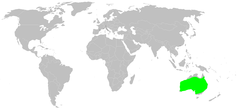Missulena occatoria
| Red-headed mouse spider | |
|---|---|
| | |
| male | |
| | |
| female | |
| Scientific classification | |
| Kingdom: | Animalia |
| Phylum: | Arthropoda |
| Subphylum: | Chelicerata |
| Class: | Arachnida |
| Order: | Araneae |
| Infraorder: | Mygalomorphae |
| Family: | Actinopodidae |
| Genus: | Missulena |
| Species: | M. occatoria |
| Binomial name | |
| Missulena occatoria Walckenaer, 1805[1] | |
 | |
| Synonyms[1] | |
| |
Missulena occatoria, known as the red-headed mouse spider, is found in Southern Australia,[1] from open forests to desert shrublands. It is the largest (females up to 24 mm, males up to 12 mm) and most widely distributed Missulena species, because the spiderlings are wind-dispersed (ballooning). Normally this only occurs with araneomorph spiders, mygalomorph spiders normally disperse by walking. Missulena venom may be very toxic, but few cases of serious envenomation have been recorded. Most recorded bites only caused minor effects, with Australian funnel-web spider antivenom having proved effective as a treatment.[2]
The spiders dig a burrow up to 55 cm deep, with two trapdoors.
While the females are black with a red tinge, the males have a bright red head and jaws, and a gunmetal blue-black abdomen.
Taxonomy
Missulena occatoria was first described by Charles Athanase Walckenaer in 1805. There has been some confusion between this species and Missulena insignis. For example, H. Womersley in 1943 regarded Actinopus formosus as a synonym of M. occatoria,[3] whereas Barbara York Main in 1985 treated it as a synonym of M. insignis,[4] the position adopted by the World Spider Catalog.[5] She considered that Womersley had partly confused M. occatoria and M. insignis, with M. occatoria only occurring in eastern Australia.[4] According to Framenau et al., M. occatoria and M. insignis cannot be differentiated based on the original description.[6]
References
- 1 2 3 "Taxon details Missulena occatoria Walckenaer, 1805", World Spider Catalog, Natural History Museum Bern, retrieved 2016-03-15
- ↑ Australian Museum: Red-headed Mouse Spider, Missulena occatoria
- ↑ Womersley, H. (1943), "A revision of the spiders of the genus Missulena Walckenaer 1805", Records of the South Australian Museum, 7: 249–269
- 1 2 Main, B.Y. (1985), "Mygalomorphae", in Walton, D.W., Zoological Catalogue of Australia, 3, Canberra: Bureau of Flora and Fauna, pp. 1–48
- ↑ "Taxon details Missulena insignis (O. Pickard-Cambridge, 1877)", World Spider Catalog, Natural History Museum Bern, retrieved 2016-03-15
- ↑ Framenau, V.; Miglio, L.; Harms, D. & Harvey, M. (2014), "Four new Mouse Spider species (Araneae, Mygalomorphae, Actinopodidae, Missulena) from Western Australia. ZooKeys 410: 121-148. doi: 10.3897/zookeys.410.7156", ZooKeys, 410: 121–148, doi:10.3897/zookeys.410.7156
External links
| Wikimedia Commons has media related to Missulena occatoria. |